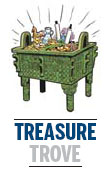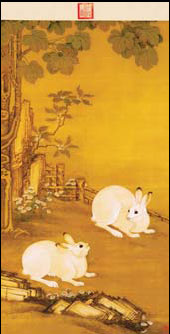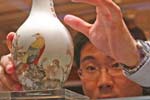Art
Rabbits inhabit a special spot in painting's past
Updated: 2011-02-01 07:54
By Zhu Linyong (China Daily)
Qing Dynasty (1644-1911) court painter Leng Mei's gongbi (fine-brush) ink painting Double Rabbits Under the Scholar Trees has been capturing growing public attention as the Year of the Rabbit approaches.
The scene depicted in this artwork has been appearing on a growing number of souvenir coins, replica paintings and, particularly appropriately, calendars.
Leng (1669-1742), a Shandong province native, lived under Qing emperors Kangxi, Yongzheng and Qianlong.
His signature ink-on-silk work Double Rabbits Under the Scholar Trees is displayed in the Palace Museum's collection.
 |
Celebrated as "the best ink portrayal of rabbits created for Qing Emperor Kangxi", the work features two white rabbits dallying beside two scholar trees. It's 1.76 meters high and 95 cm wide.
The rabbits' depictions are realistic in every way, from the glints in their eyes to the textures of their fur.
The work is said to be a festive piece painted for Emperor Kangxi. Consequently, it features certain auspicious meanings.
The rabbit is hailed as an auspicious animal that brings good luck, fortune and happiness. And depictions featuring two of the creatures symbolize double happiness.
Ancient Chinese also believed depictions of two scholar trees represent romance or harmony.
Consequently, this work appears to be a typical hua niao hua, or birds-and-flowers painting.
However, the approach the painter used to render the traditional genre is somewhat unconventional.
The work apparently borrows influences from Western paintings, such as the use of perspective, says Sophia Law, a researcher with Hong Kong's Lingnan University, who examines the work in her book Beyond Forms and Colors: Six Ways to Read Chinese Paintings.
In the early Qing Dynasty, Western missionaries introduced to China not only the Christian faith but also Western art genres and concepts, such as perspective, trompe-l'oeil, and lighting and shading.
Leng was known for his lifelong effort to establish a style that bridged East and West.
 |
In Double Rabbits Under the Scholar Trees, he paid special attention to presenting the animals in appropriate proportions.
Contrary to the common practice of liubai, or leaving blank spaces, Leng also successfully created elaborately rendered, realistic foregrounds and backgrounds. These are filled with lush trees, wildflowers, rocks and mountaintops in the distance.
Consequently, his work is very much like a photo that captures a realistic scene.
"Traditional artists usually left large areas of blank space after they painted the main subject," Law explains.
"They would not fill a picture with too many details but gave the viewers enough room for imagination."
Traditionally, the emperor would suggest the subject matter. The painter would then create a draft for the emperor's approval before beginning work on the final product.
But Leng was so diligent and gifted that he won the trust of emperors Kangxi and Qianlong, who often gave him freedom to complete ink pieces according to his own ideas, Qing court records show.
Leng's painting style exerted an influence on various folk arts, such as New Year woodcut prints, from the Qing dynasty on, experts say.
During his five-decade career, Leng proved to be a versatile artist who churned out hundreds of vivid figures, birds-and-flowers paintings, depictions of royal architecture and visual interpretations of historical tales.
Unfortunately, many of Leng's original works were burned when the allied armies of Great Briton and France stormed Yuanmingyuan, or the Old Summer Palace, where Leng's paintings were abundant, in October 1860.
China Daily
Specials

Share your China stories!
Foreign readers are invited to share your China stories.

Art auctions
China accounted for 33% of global fine art sales.

Waiting for drivers' seat
Lack of sponsorship appears to be why Chinese drivers have yet to race in a Formula 1 event